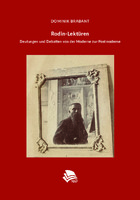Rodin-Lekturen
Deutungen und Debatten von der Moderne zur Postmoderne
| dc.contributor.author | Brabant, Dominik | |
| dc.date.accessioned | 2017-11-02 00:00:00 | |
| dc.date.accessioned | 2020-04-01T13:23:28Z | |
| dc.date.available | 2020-04-01T13:23:28Z | |
| dc.date.issued | 2017 | |
| dc.identifier | 638990 | |
| dc.identifier | OCN: 1030821042 | en_US |
| dc.identifier.uri | http://library.oapen.org/handle/20.500.12657/31090 | |
| dc.description.abstract | the title Figurenkunst und Künstlerfigur turns to the art-critical writings on the Gates of Hell (1880). In this chapter, famous art critics and writers such as Edmond de Goncourt, Gustave Geffroy, Anatole France and Arthur Symons are at the centerof interest. For the generation of the symbolist art critics, for example, the Gates of Hell became an icon of their own melancholic art doctrine insofar as the art work seemed to stage a temporality of deferral and hesitation which could be understood as a counter-image to an all-too-optimistic belief in historical progress. At the same time, Rodin’s apparent inability to bring this work to an end seemed to betray a very similar understanding of time. Rilke’s and Simmel’s interpretations of Rodin’s work, which are at the core of the following chapter, are described as theoretically ambitious attempts of emulating the art-critical debate at the turn of the century by using innovative narrative strategies of coalescing biographical patterns and reflections on art (Rilke) or by declaring Rodin’s work to be the ideal object for an analysis of modernity in the context of contemporary sociology (Simmel). The sixth chapter, entitled Verlust und Wiederbelebung, turns to two interpretations by German-speaking authors in the years around 1950: the philosopher Günther Anders and the art historian Josef Schmoll. gen. Eisenwerth. Anders, who was also a student of Edmund Husserl, described Rodin’s sculptural images of the human body as artistic expressions of an historical experience of loss and isolation, as objects which could stimulate a deepened reflection about modernity as crises. Josef Schmoll gen. Eisenwerth’s investigations of the motif of the torso, which emerged in the 1950s, rather tried to describe the fragmented body as the »symbol« of an aesthetic experience of totality and holism. Obviously, the art historian’s strategy of emphatically denying the disturbing aesthetic effects of some of Rodin’s torsos can be – at least from today’s perspective – conceived as a way of dealing with the historical experience of the collapse of civilization. The last chapter of the study is entitled Auf dem Weg in die Postmoderne. It focuses on the writings of Leo Steinberg and Rosalind Krauss since the 1960s. While Steinberg was mostly interested in the diverse ways of how Rodin constructed and deconstructed the meanings of his sculptures with the help of the art forms of the »montage« and the »assemblage«, thereby ostentatiously demonstrating the sculptural »semiosis«, Krauss emphatically turned to the problem of ›reading‹ Rodin’s images of the human body. For her, Rodin’s sculptures became emblems of an ›opaque‹ subjectivity and therefore the first artistic realizations of a radically new paradigm of aesthetic reception: Instead of clinging to the traditional notions of psychological and hermeneutical depth in the beholding of sculptures, in her view Rodin’s sculptures emphasize the material surface as the original site of the production of meaning." | |
| dc.language | German | |
| dc.subject.classification | thema EDItEUR::A The Arts::AB The arts: general topics::ABA Theory of art | en_US |
| dc.subject.classification | thema EDItEUR::A The Arts::AG The Arts: treatments and subjects::AGA History of art | en_US |
| dc.subject.classification | thema EDItEUR::3 Time period qualifiers::3M c 1500 onwards to present day::3MN 19th century, c 1800 to c 1899 | en_US |
| dc.subject.classification | thema EDItEUR::3 Time period qualifiers::3M c 1500 onwards to present day::3MP 20th century, c 1900 to c 1999 | en_US |
| dc.subject.classification | thema EDItEUR::A The Arts::AF The Arts: art forms::AFK Non-graphic and electronic art forms::AFKB Sculpture | en_US |
| dc.subject.classification | thema EDItEUR::N History and Archaeology::NH History | en_US |
| dc.subject.other | postmodernity | |
| dc.subject.other | auguste rodin | |
| dc.subject.other | sculpture | |
| dc.subject.other | modernity | |
| dc.subject.other | naturalism | |
| dc.subject.other | esthetic | |
| dc.subject.other | art criticism | |
| dc.subject.other | Bildhauerei | |
| dc.subject.other | Plastik (Kunst) | |
| dc.subject.other | Rainer Maria Rilke | |
| dc.title | Rodin-Lekturen | |
| dc.title.alternative | Deutungen und Debatten von der Moderne zur Postmoderne | |
| dc.type | book | |
| oapen.identifier.doi | 10.16994/bah | |
| oapen.relation.isPublishedBy | a6e7b6f5-b321-4b99-bf66-dacbeb5d7daa | |
| oapen.relation.isbn | 9783946198253;9783946198260;9783946198277 | |
| oapen.pages | 328 | |
| oapen.place.publication | Cologne | |
| oapen.remark.public | Relevant Wikipedia pages: Auguste Rodin - https://de.wikipedia.org/wiki/Auguste_Rodin; Bildhauerei - https://de.wikipedia.org/wiki/Bildhauerei; Plastik (Kunst) - https://de.wikipedia.org/wiki/Plastik_(Kunst); Rainer Maria Rilke - https://de.wikipedia.org/wiki/Rainer_Maria_Rilke | |
| oapen.identifier.ocn | 1030821042 |

